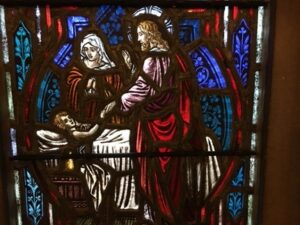 It’s been a while since I started the project of describing the scenes in the eight stained-glass windows along the sanctuary aisles. The last window to mention is the one closest to the lectern up front. It shows Jesus standing at the bedside of a child with one hand raised and the other holding the child’s hand. A woman stands behind the bed with her hands crossed in prayer.
It’s been a while since I started the project of describing the scenes in the eight stained-glass windows along the sanctuary aisles. The last window to mention is the one closest to the lectern up front. It shows Jesus standing at the bedside of a child with one hand raised and the other holding the child’s hand. A woman stands behind the bed with her hands crossed in prayer.
I am not sure just what passage from the Gospel this window refers to. A printed guide to the building says the window portrays “Jesus raising the widow’s son” which is found in Luke 7:11-17. That describes Jesus having compassion on a widow who has clearly lost both her husband and now her son. Jesus speaks and the son sat up and began to speak himself. Jesus restored the son him to his mother. However, the passage explicitly describes the son not as a child but an adult man. What’s more, the passage says he is being carried on a stretcher in the street rather than laying at home on a bed. So, this passage doesn’t fit the scene in the stained-glass window.
There is another passage that seems a better fit. It’s the account of Jairus’s daughter found in Mark 5:35-43 and also Luke 8:49-56. Jairus, a leader in the local synagogue, came to Jesus and asked him to heal his daughter. She later died and Jesus came to the house. There were lots of people there who were crying and wailing. They told Jesus he was too late to be of help, but he dismissed them and went into the room where the girl was, along with the girl’s mother and father and his disciples. We read, “Taking her hand, he said to her, ‘Talith koum,’ which means, ‘Young woman, get up.’ Suddenly the young woman got up and began to walk around. She was 12 years old.” (vv. 41-42).
All three of these passages point to Jesus as a worker of miracles who has authority over life and death. He tells those who are present to hold off on crying and grieving because he has come to bring life. This is shocking news, to be sure. Why raise these individuals back to life and not others? How might these stories shape how we think about our own death and the death of loved ones? These stories reveal Jesus’ power and purpose, but they only begin to make sense in light of the resurrection life that Jesus opens up for all his followers through his own death and resurrection. The fuller meaning is still to be worked out for us all.
The next time you are in the sanctuary, take a look around at all 8 of these windows. Together they remind us in a visual way of the Lord and Savior we come to worship in spirit and in truth.
Grace and peace,
Pastor Steve Larsen
